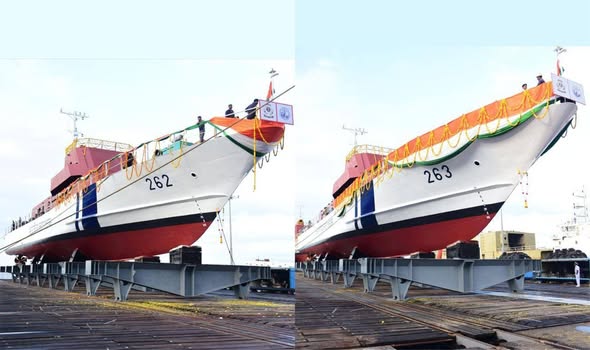ICG’s Fast Patrol Vessel Duo: Ajit and Aparajit Fortify India’s Maritime Frontier
On October 24, 2025, the Indian Coast Guard (ICG) marked a pivotal stride in maritime security with the launch of two advanced Fast Patrol Vessels (FPVs), ICGS Ajit and ICGS Aparajit, at Goa Shipyard Limited (GSL). This indigenous commissioning — the latest in a series of eight FPVs under a ₹700 crore contract — underscores India’s accelerating push toward Aatmanirbhar Bharat in naval engineering. As Indo-Pacific waters simmer with geopolitical friction, these 51-meter, 400-tonne vessels emerge as agile sentinels, blending speed, surveillance, and strike capability to safeguard a 7,500 km coastline.
Technical Backbone: Engineering for High-Seas Agility
Designed and built entirely at GSL — a public sector undertaking with over six decades of expertise — Ajit and Aparajit boast cutting-edge features tailored for multi-mission ops. Their GRP-hulled construction (Glass Reinforced Plastic) ensures stealthy radar evasion, while twin MTU diesel engines propel them to a blistering 33 knots, with an endurance of 2,000 nautical miles at 16 knots.
| Specification | Details | Strategic Edge |
|---|---|---|
| Displacement | 400 tonnes | High maneuverability in EEZ patrols |
| Weapons Suite | 76mm OTO Melara gun, 12.7mm machine guns, 20mm CRN-91 | Anti-piracy & asymmetric threat neutralization |
| Sensors | Searchlight, IR/EO cameras, LORAN navigation | 24/7 ISR in contested littorals |
| Indigenous Content | 75% (engines, hull, electronics) | Reduces import dependency by ₹500 Cr |
The vessels’ indigenous fire control systems, developed by Bharat Electronics Limited (BEL), integrate seamlessly with the ICG’s National Automatic Identification System (NAIS), enabling real-time tracking of 1,000+ vessels daily. This tech infusion — echoed in the INS Androth commissioning — fortifies shallow-water anti-submarine warfare (ASW), critical against submarine incursions in the Arabian Sea.
Historical Evolution: From Legacy Patrols to Modern Sentinels
The FPV program traces its roots to the 1980s, when ICG’s aging fleet struggled against smuggling and poaching. Post-26/11 Mumbai attacks, a modernization drive birthed the ABG-3 class, but Ajit and Aparajit represent a quantum leap: 75% indigenous content versus 40% in predecessors. GSL’s role, pivotal since delivering 101 patrol vessels since 1967, aligns with the MoD’s 51% FY25-26 capex utilization — as detailed in September’s acceleration report.
Expert insight from Capt. (Retd.) D.K. Sharma, former ICG commander:
“These FPVs aren’t just boats — they’re force multipliers. In an era of hybrid threats, their speed and sensors turn reactive patrols into proactive deterrence.”
Geopolitical Imperative: Countering Shadows in the Indian Ocean
As China’s Yuan Wang 5 tracking ship lingers in the IOR — per recent NOTAMs for India’s missile tests — Ajit and Aparajit plug gaps in domain awareness. Stationed at Porbandar and Mumbai, they’ll enforce EEZ compliance, interdicting illicit arms flows amid Houthi disruptions in the Red Sea. This dovetails with AUSTRAHIND 2025’s Quad synergies, where ICG-Australian Coast Guard drills honed joint EEZ enforcement.
Broader canvas: India’s defence exports hit ₹25,000 Cr in FY25, led by BrahMos — a surge that positions GSL for export bids. Yet challenges persist: engine imports (MTU) highlight supply chain vulnerabilities, urging faster localization under DPM 2025.
Future Horizon: Scaling the Indigenous Fleet
By 2027, ICG eyes 24 more FPVs under Next Gen Offshore Patrol Vessels, integrating DRDO’s anti-drone jammers. Synergy with thorium-based propulsion could yield hybrid-electric variants, slashing fuel costs by 30%. Amid Operation Sindoor’s lessons — where coastal assets proved decisive — these vessels herald a resilient blue economy.
Strategic Impact: Ajit and Aparajit elevate ICG from guardian to guarantor, weaving indigenous steel into the fabric of Indo-Pacific stability. In Strategy. Strength. Sovereignty., they sail as harbingers of unchallenged dominion.



